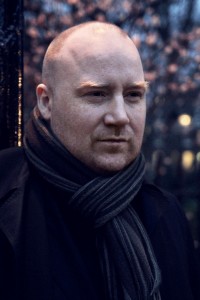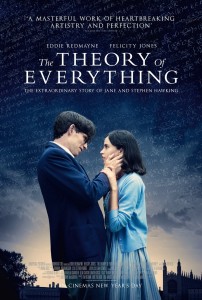Composer Jóhann Jóhannsson — On Scoring "The Theory of Everything," Abbey Road, and Unusual Inspiration
Jóhann Jóhannsson is on a roll – of a different sort. The circular motion of the imagery in the brilliant film that he scored, The Theory of Everything, inspired the spherical structures of the unforgettable music he created for it.

Jóhann Jóhannsson could capture an Academy Award this Sunday for scoring “The Theory of Everything”.
Onscreen, Jóhannsson saw bicycles, motorized wheelchairs, and the massive gears spinning inside the head of theoretical physicist Stephen Hawking, and got ideas of his own. The result is a very special soundtrack, one which advances classical arrangements with an utterly fresh and dynamic feel.
No wonder it recently earned the diverse Iceland-born composer a Golden Globe Award for “Best Original Score” and there may be more to come. It’s also earned him an Oscar nomination for “Best Score”, one of five that the film is eligible to receive at the 87th Academy Awards taking place this Sunday in Hollywood.
During a pre-awards tour of NYC, the 45 year-old Jóhannsson — whose growing portfolio spans a progressive list of features, short films, TV documentaries, and plays – spoke with SonicScoop about his own unique angle on film scoring, while also breaking his silence on studio secrets with some rare tech talk.
What is it about Iceland that generates such interesting musicians?
That’s a good question! (Laughs) One that’s a little bit hard to answer.
I think we have a strong history of being storytellers, which is deeply ingrained in the Icelandic national identity. The people who wrote the Nordic sagas a thousand years ago were all Icelanders. The Icelanders were the bards and poets of the Scandinavian and Nordic courts. It was Icelanders who were recording the stories of their Nordic kin, and putting those mythologies in writing.
So it’s a strong part of the national identity to be storytellers, artists, and poets – it doesn’t feel like a weird undertaking to become an artist. I think it’s something that’s very accepted in the society, and there’s something about a close-knit community that’s very cooperative. Everyone is in three or four bands, everyone plays in each other’s band. It’s a very good place to develop your sounds, and I spent years there, just playing with different people and experimenting.
Iceland is a good place to hone your craft for a very small audience. Then, once you get good, you take it further – you go out into the wide world and spread your wings. That’s how a lot of Icelandic artists have developed.
OK, I’m going to out you now: Tell me about your personal studio – what instruments and tools are there for the purpose of songwriting and creating demos?
Most of the writing happens either on piano or guitar, or just in my head. I go out on walks, I hum, and ideas can just sort of occur anywhere.
The main thing is to be open and be receptive. My main challenge when working out a project is to be in a receptive state, where ideas come to you. That is almost half the battle. It’s almost spiritual. I’m not a hugely spiritual person, but I have that side of me, where you really have to put yourself in strong contact with your subconscious: Turn off the inner censor and open up for an idea from your innermost, visceral self. That’s where the ideas come from.
In terms of the equipment used, it’s almost irrelevant to me. I think I use a lot of the same libraries as most composers use, and a lot of the same techniques. I’ve written scores just on my laptop, using something like Vienna Philharmonic. I also use Spitfire quite a lot. I think every library has its own characteristics, and you have to find the strengths of each one.
I do create very detailed demos – it depends quite a bit on the project. Certainly for a film like “The Theory of Everything” I created very detailed demos, and I orchestrated every single voice, every single instrument. Even though I use an orchestrator to do the layouts and to put it into Finale or Sibelius, I make all the creative decisions. I feel it’s very important as a way of communicating with the director to make the demos very detailed, and make them very precise.
Also in the demo process, I do a lot of recording. I don’t rely only on samples, because samples can be very limited – you can only do so much with them. During the demo process I bring in players to perform and record, and in a sense I’m creating my own libraries and sample banks when I’m writing. That’s because a lot of the libraries are wonderful, but they are also limited, and made for a lot of generalized purposes – they’re going for the common denominator in a sense.
If you want to go outside of that, and create your own sounds, you have to create your own samples and libraries. I do a lot of that, and I bring in players – obviously not a whole orchestra, but a least a couple of musicians to enhance the demos and do things that libraries cannot do.
You had the privilege of recording at the famed Abbey Road Studios, and you said that it sounds “like no other room”. Can you characterize that sound in more detail?
It’s a sound that has a lot of space. It’s not fair to compare Air and Abbey Road Studios, which are the main orchestra rooms in London. Air is wonderful – I recorded Prisoners in there – it has a shorter reverb time, but a lot of space.
At Abbey Road, there’s an acoustic property that allows every instrument to be very clearly heard, it’s just perfectly suited to an orchestra of a certain size. It allows each instrument to really define its own space in the spectrum. So if you have a good piece of music, and it’s well orchestrated and arranged, you can get a sound there unlike any other.
I think it’s also a great-sounding room to play in, so the players feel good there. That’s very important!
– David Weiss







